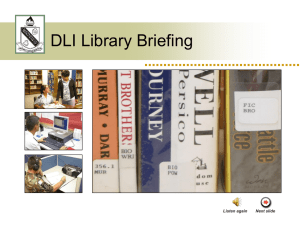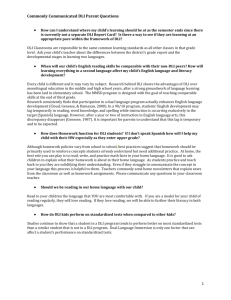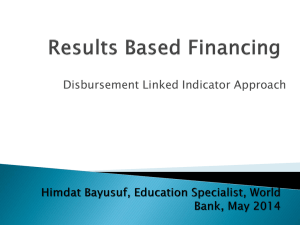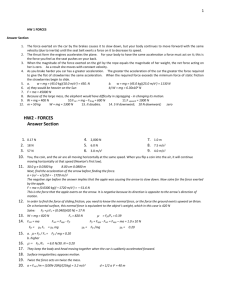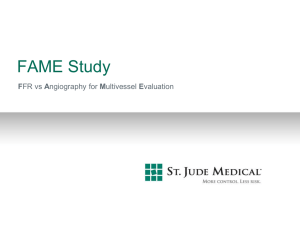SUPPLEMENTAL MATERIAL Supplement Appendix Methods Study
advertisement
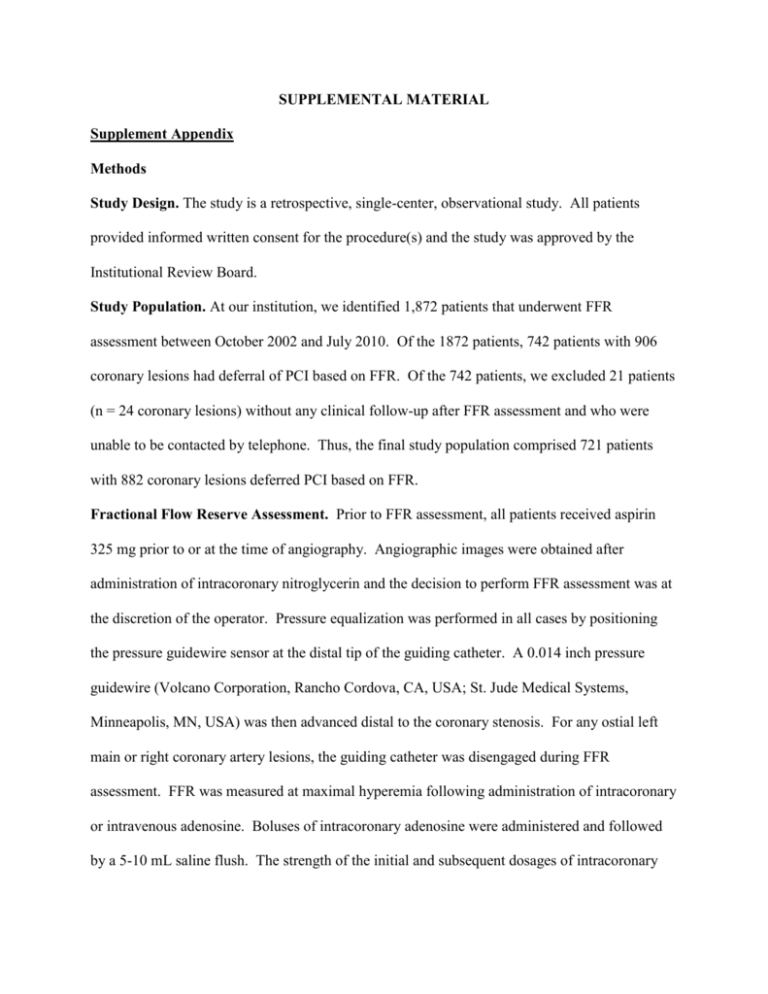
SUPPLEMENTAL MATERIAL Supplement Appendix Methods Study Design. The study is a retrospective, single-center, observational study. All patients provided informed written consent for the procedure(s) and the study was approved by the Institutional Review Board. Study Population. At our institution, we identified 1,872 patients that underwent FFR assessment between October 2002 and July 2010. Of the 1872 patients, 742 patients with 906 coronary lesions had deferral of PCI based on FFR. Of the 742 patients, we excluded 21 patients (n = 24 coronary lesions) without any clinical follow-up after FFR assessment and who were unable to be contacted by telephone. Thus, the final study population comprised 721 patients with 882 coronary lesions deferred PCI based on FFR. Fractional Flow Reserve Assessment. Prior to FFR assessment, all patients received aspirin 325 mg prior to or at the time of angiography. Angiographic images were obtained after administration of intracoronary nitroglycerin and the decision to perform FFR assessment was at the discretion of the operator. Pressure equalization was performed in all cases by positioning the pressure guidewire sensor at the distal tip of the guiding catheter. A 0.014 inch pressure guidewire (Volcano Corporation, Rancho Cordova, CA, USA; St. Jude Medical Systems, Minneapolis, MN, USA) was then advanced distal to the coronary stenosis. For any ostial left main or right coronary artery lesions, the guiding catheter was disengaged during FFR assessment. FFR was measured at maximal hyperemia following administration of intracoronary or intravenous adenosine. Boluses of intracoronary adenosine were administered and followed by a 5-10 mL saline flush. The strength of the initial and subsequent dosages of intracoronary adenosine was determined by the operator. Following each intracoronary adenosine bolus, measurements of aortic and distal coronary pressures were made simultaneously and compared to baseline measurements. Continuous hemodynamic and electrocardiographic monitoring was recorded during intracoronary adenosine administration. Maximal hyperemia was induced by successively increasing the intracoronary adenosine dose to the highest tolerated dose. For intravenous administration, adenosine (140 μg/kg/min) was infused for at least two minutes to achieve a steady-state concentration prior to FFR measurement. The equivalence between intracoronary and intravenous adenosine administration for FFR assessment has been described previously.1 The FFR cut-off used for deferring PCI based on FFR assessment in our institution from 2002 to 2008 was > 0.75, as described in the DEFER (FFR to Determine Appropriateness of Angioplasty in Moderate Coronary Stenoses) study.2 In approximately late 2008, the FFR cut-off for lesion deferral changed to > 0.80, with presentation and publication of the FAME (Fractional flow reserve versus Angiography for Multi-vessel Evaluation) trial.3 PCI of any other coronary lesion(s) at the time of target lesion FFR assessment was performed using standard coronary intervention techniques as determined by the operator. Clinical follow-up and endpoint. For every participant, follow-up was assessed by review of the medical record and/or telephone interview. Patients were followed from the date of index stenting through 12/29/2012. The reasons for DLI were obtained from the medical record. Follow-up coronary angiograms were reviewed independently by two authors (J.P.D, J.S.P.). If a patient had follow-up outside our institution, medical records including angiograms were obtained for review. All angiographic outcomes were independently reviewed by an author who was not an operator in the case. The primary outcome of the study was DLI, defined as any PCI performed within 5-mm proximal or distal to or any coronary artery bypass graft (CABG) placed 2 distal to a lesion deferred revascularization based on the index FFR assessment. The clinical setting and reasons for DLI were abstracted from the medical record. As described in the FAME 2 trial, an unplanned hospitalization for urgent revascularization was defined as any hospitalization that occurred unexpectedly due to persisting or increasing angina with or without ST-segment/T-wave ECG changes or elevated cardiac biomarkers and coronary revascularization was performed within the same hospitalization.4 Acute myocardial infarction (AMI) was defined according to the guidelines set forth by the Academic Research Consortium guidelines.5 Unstable angina, ST-segment or T-wave ECG changes, and a positive stress test were defined according to standard guidelines.6 Statistical Methods. Patient and lesion-level covariates that were known at the time of FFR assessment were considered for the prediction model. With the exception of one patient who was missing a creatinine level, none of the covariates analyzed for the study contained missing data. First, the association between potential predictor covariates and DLI was assessed using univariate Cox proportional hazards models. A marginal Cox proportional hazards model approach was used to account for correlated data in patients having multiple deferred lesions.7, 8 To create a parsimonious prediction model, Spearman correlation coefficients were used to examine the linear relationship between each covariate pair. Tolerance values were also examined to identify multicollinearity. Covariate pairs with strong correlations and/or small tolerance values (< 0.10) were considered for exclusion from the full prediction model. Variables that were considered for the full prediction model included both clinically and statistically significant associations with DLI. The relationship between candidate variables and DLI was examined using a multivariable Cox proportional hazards model. The full model was 3 reduced using a stepwise variable selection technique employing a threshold p < 0.20 for entry and p > 0.05 for removal. The reduced model was internally validated for discrimination and calibration using bootstrapping techniques to adjust for overfitting and over-optimistic model performance. Discrimination was evaluated using a survival-based c statistic to describe the overall ability of the final model to distinguish DLI events and DLI non-events during follow-up.9, 10 An optimism-corrected c statistic was calculated using 500 bootstrap samples that were created with replacement. A Cox proportional hazards model was built for each bootstrap sample using the same stepwise variable selection technique as the original sample. Predicted values for DLI were created from the bootstrap model and used to create a bootstrap c statistic. For each bootstrap sample, a c statistic difference was calculated by subtracting the bootstrap sample c statistic from the original sample c statistic. The mean c statistic difference was subtracted from the original sample c statistic to calculate an optimism-corrected survival-based c statistic. Calibration was assessed using a calibration slope to describe the agreement between predicted DLI events and observed DLI events. For each bootstrap sample, the predicted value of DLI was used as the independent variable in a Cox regression model to examine agreement with observed DLI events in the original sample. The mean calibration slope across all bootstrap samples was used to assess calibration for the model. The final Cox proportional hazards model is presented as an algorithm using the regression coefficients from the model. Using the algorithm, the probability of DLI within oneyear following deferred PCI based on FFR assessment was calculated. The one-year probability of freedom from DLI was estimated from the algorithm and compared with the observed oneyear Kaplan-Meier estimates for freedom from DLI to additionally examine model fit. A 4 calibration plot was created to visually inspect the apparent model fit by comparing the mean predicted probability quintiles for one-year freedom from DLI estimated from the algorithm with one-year Kaplan-Meier quintile estimates. All statistical analyses were performed using SAS 9.3 (SAS Institute, Cary, North Carolina). All comparisons were 2-tailed. A p-value < 0.05 was considered statistically significant. ADDITIONAL RESULTS Reasons for DLI in Patients with Unstable Angina without ECG Changes (Figure 1) In DLI lesions revascularized for unstable angina without ECG changes (n = 53 of 71), 7 lesions underwent revascularization based on a recent (within 3 months) positive stress test, 3 lesions for a repeat FFR measurement < 0.80, 6 lesions were stented based on intravascular ultrasound (IVUS) findings, and the remaining 37 lesions were revascularized for progressive symptoms. Reasons for DLI in Patients with Stable Angina (Figure 1) In the DLI lesions that were revascularized for stable angina, 22 had a recent positive stress test, 5 had a repeat FFR measurement < 0.80, 6 lesions were stented due to IVUS findings, and 19 lesions were revascularized for persistent symptoms despite medical treatment. Clinical Settings of DLIs Occurring Within or Beyond the First-year After Deferred Revascularization DLIs that occur within the first-year following deferral of revascularization present with a numerically higher rate of urgent revascularization compared with DLIs performed beyond the first-year after deferral (77% vs. 60%, p =0.10); namely due to a significantly higher rate of unstable angina without ECG changes (49% vs. 28%, p = 0.02) (Supplemental Table 1). No 5 significant differences were observed in the rates of AMI between DLIs performed within or beyond the first-year after deferred revascularization. Predicted vs. Observed One-year DLI Rates Using the mean values and observed study proportions of each predictor variable (age = 65; current or former smoking = 52%; history of CAD or prior PCI = 68%, creatinine = 0.9, multivessel CAD = 64%, and FFR value = 0.87), the predicted rate of DLI using the algorithm at one-year was 4.4%. Based on the Kaplan-Meier curve (Supplemental Figure 1) for DLI following deferred revascularization after FFR, freedom from DLI at one-year was 94.6%, or alternatively the observed incidence of DLI at one-year was 5.4%. Final Model Calibration and Assessment The mean calibration slope describing the agreement between predicted DLI events across all bootstrap samples and the observed DLI events in the original sample was 0.822, where a value of 1.0 implies perfect agreement. To assess goodness-of-fit, patients were divided into quintiles based on the predicted probability of one-year freedom from DLI estimated from the final algorithm. Within each quintile, the mean probability was plotted against the observed one-year Kaplan-Meier estimate (Supplemental Figure 2). Using the quintiles of predicted risk, we stratified the risk for DLI at one year into three categories: low (< 3% = lowest quintile), intermediate (3-7% = 3 middle quintiles), and high risk (> 7% = highest quintile). 6 Calculation of the predicted one-year risk of DLI for a hypothetical lesion deferred revascularization based on FFR using the final algorithm. We provide an example of a hypothetical lesion to illustrate how to calculate the one-year predicted risk of DLI from the algorithm derived from the final Cox proportional hazards model. The hypothetical lesion has the following characteristics: Age: 60 Creatinine (mg/dL): 1.1 FFR value: 0.84 Current or former smoking (smoker): Yes = 1 History of CAD or prior PCI (CADHx): No = 0 Multivessel CAD (MultiCAD): Yes = 1 The formula used to calculate freedom from DLI at one-year following deferred revascularization after FFR is: s = 0.169𝑒 −0.02075∗𝐚𝐠𝐞+0.13681∗𝐜𝐫𝐞𝐚𝐭𝐢𝐧𝐢𝐧𝐞−3.81032∗𝐅𝐅𝐑+0.39710∗𝐬𝐦𝐨𝐤𝐞𝐫+0.48086∗𝐂𝐀𝐃𝐇𝐱+0.51777∗𝐌𝐮𝐥𝐭𝐢𝐂𝐀𝐃 where smoker, CADHx, and MultiCAD are set to 1 if present and 0 otherwise. The probability of DLI at one-year following deferred revascularization after FFR is: 1−s The calculated risk for DLI at one-year following deferred revascularization based on FFR for our hypothetical lesion is calculated as follows: s = 0.169𝑒 −0.02075∗𝟔𝟎+0.13681∗𝟏.𝟏−3.81032∗𝟎.𝟖𝟒+0.39710∗𝟏+0.48086∗𝟎+0.51777∗𝟏 s = 0.169𝑒 −3.38031 s = 0.941282 𝑜𝑟 94.1% 𝑓𝑟𝑒𝑒𝑑𝑜𝑚 𝑓𝑟𝑜𝑚 𝐷𝐿𝐼 𝑎𝑡 𝑜𝑛𝑒 − 𝑦𝑒𝑎𝑟 1 − s = 0.058718 = 5.9% 𝑟𝑖𝑠𝑘 𝑜𝑓 𝐷𝐿𝐼 𝑎𝑡 𝑜𝑛𝑒 − 𝑦𝑒𝑎𝑟 An online tool (www.DLI.wustl.edu) is available to calculate the one-year risk of DLI in lesions deferred revascularization following FFR assessment. 7 References 1. Jeremias A, Whitbourn RJ, Filardo SD, Fitzgerald PJ, Cohen DJ, Tuzcu EM, Anderson WD, Abizaid AA, Mintz GS, Yeung AC, Kern MJ, Yock PG. Adequacy of intracoronary versus intravenous adenosine-induced maximal coronary hyperemia for fractional flow reserve measurements. Am Heart J 2000;140:651-657. 2. Bech GJ, De Bruyne B, Pijls NH, de Muinck ED, Hoorntje JC, Escaned J, Stella PR, Boersma E, Bartunek J, Koolen JJ, Wijns W. Fractional flow reserve to determine the appropriateness of angioplasty in moderate coronary stenosis: a randomized trial. Circulation 2001;103:2928-2934. 3. Tonino PA, De Bruyne B, Pijls NH, Siebert U, Ikeno F, van't Veer M, Klauss V, Manoharan G, Engstrom T, Oldroyd KG, Ver Lee PN, MacCarthy PA, Fearon WF, FAME study Investigators. Fractional flow reserve versus angiography for guiding percutaneous coronary intervention. N Engl J Med 2009;360:213-224. 4. De Bruyne B, Pijls NH, Kalesan B, Barbato E, Tonino PA, Piroth Z, Jagic N, Mobius- Winkler S, Rioufol G, Witt N, Kala P, MacCarthy P, Engstrom T, Oldroyd KG, Mavromatis K, Manoharan G, Verlee P, Frobert O, Curzen N, Johnson JB, Juni P, Fearon WF, FAME 2 Trial Investigators. Fractional flow reserve-guided PCI versus medical therapy in stable coronary disease. N Engl J Med 2012;367:991-1001. 5. Cutlip DE, Windecker S, Mehran R, Boam A, Cohen DJ, van Es GA, Steg PG, Morel MA, Mauri L, Vranckx P, McFadden E, Lansky A, Hamon M, Krucoff MW, Serruys PW, Academic Research Consutrium. Clinical end points in coronary stent trials: a case for standardized definitions. Circulation 2007;115:2344-2351. 8 6. Cannon CP, Brindis RG, Chaitman BR, Cohen DJ, Cross JT, Jr., Drozda JP, Jr., Fesmire FM, Fintel DJ, Fonarow GC, Fox KA, Gray DT, Harrington RA, Hicks KA, Hollander JE, Krumholz H, Labarthe DR, Long JB, Mascette AM, Meyer C, Peterson ED, Radford MJ, Roe MT, Richmann JB, Selker HP, Shahian DM, Shaw RE, Sprenger S, Swor R, Underberg JA, Van de Werf F, Weiner BH, Weintraub WS. 2013 ACCF/AHA key data elements and definitions for measuring the clinical management and outcomes of patients with acute coronary syndromes and coronary artery disease. J Am Coll Cardiol 2013;61:992-1025. 7. Lee EW, Wei LJ, Amato DA, Leurgans S. Cox-Type Regression Analysis for Large Numbers of Small Groups of Correlated Failure Time Observations. In: Klein JP, P.K. G, (eds). Survival Analysis: State of the Art. Dordrecht, Netherlands: Kluwer Academic Publishers; 1992, 237-247. 8. Lin DY, Wei LJ. The Robust Inference for the Proportional Hazards Model. J Am Stat Assoc 1989;84:1074-1078. 9. Harrell FE, Jr., Lee KL, Mark DB. Multivariable prognostic models: issues in developing models, evaluating assumptions and adequacy, and measuring and reducing errors. Stat Med 1996;15:361-387. 10. Pencina MJ, D'Agostino RB. Overall C as a measure of discrimination in survival analysis: model specific population value and confidence interval estimation. Stat Med 2004;23:2109-2123. 9 Supplemental Table 1: Clinical Presentation of DLIs Occurring Within and Beyond One-year Following Deferred Revascularization Based on Index FFR DLI < 1-year after index FFR (n = 47 patients) DLI > 1-year after index FFR (n = 108 patients) p- value Urgent Revascularization* Acute Myocardial Infarction STEMI NSTEMI Unstable Angina with ECG changes† Unstable Angina without ECG changes† 36 (77%) 8 (17%) 2 (4%) 6 (13%) 5 (11%) 23 (49%) 65 (60%) 22 (20%) 4 (4%) 18 (17%) 13 (12%) 30 (28%) 0.10 0.66 1.00 0.63 0.77 0.02 Elective Revascularization 11 (23%) 41(38%) 0.10 10 (21%) 40 (37%) 0.06 1 (2%) 1 (1%) 1.00 Insufficient Clinical Data 0 (0%) Values are shown as absolute numbers (percentages). 2 (2%) N/A Stable Angina Renal Transplant: Positive Stress Test *Urgent revascularization was defined as any unplanned hospitalization that occurred unexpectedly due to persisting or increasing angina with or without ST-segment/T-wave ECG changes or elevated cardiac biomarkers and coronary revascularization was performed within the same hospitalization. †ECG changes refer to new ST-segment segment and/or T-wave ECG changes at the time of clinical presentation compared with an individual's baseline ECG. N/A = not applicable. All other abbreviations as shown in Tables 1 and 2 . 10 Supplemental Figure 1: Kaplan-Meier curve for DLI The Kaplan-Meier curve estimate of the freedom from DLI following deferred revascularization based on FFR at one-year is 94.6%. 11 Supplemental Figure 2: Calibration plot based on the final Cox proportional hazard model parameter estimates. Mean predicted freedom from one-year DLI based on the final algorithm was compared with the observed Kaplan-Meier estimate within quintiles of predicted one-year freedom from DLI KM = Kaplan-Meier 12
